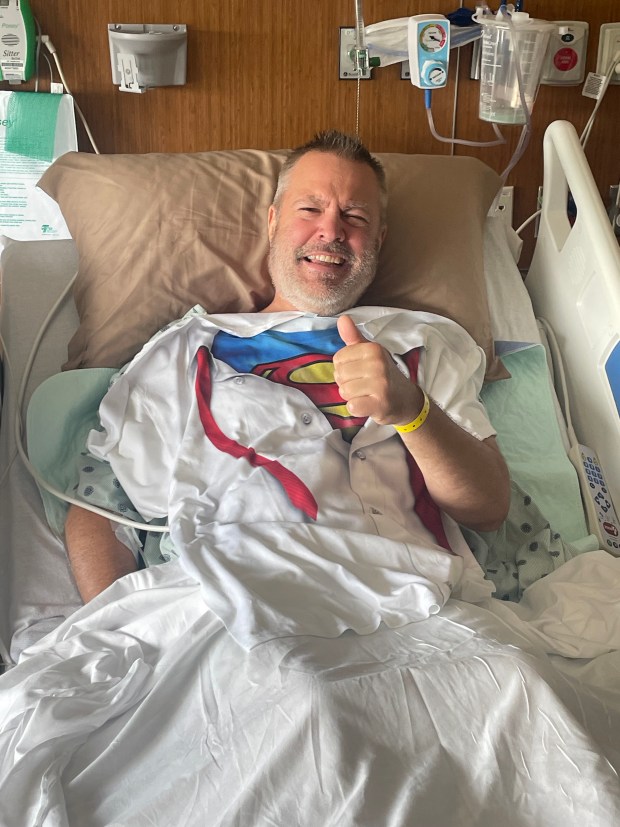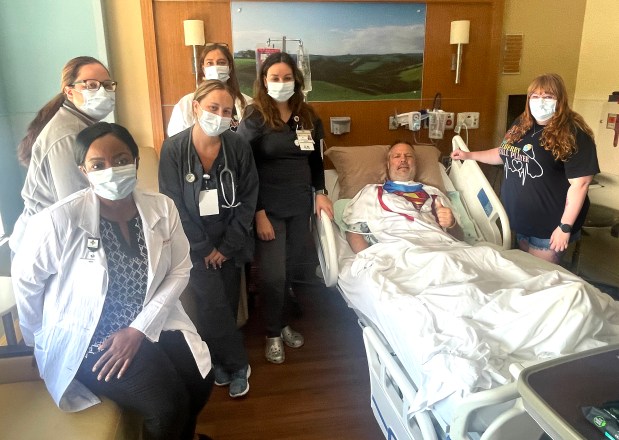A 53-year-old New Lenox man is one patient the staff on Silver Cross Hospital’s neurology floor won’t soon forget.
They marvel at how far Clarke Christiansen has come since suffering a debilitating stroke last August and being unable to move his limbs or swallow. In fact, one nurse at the New Lenox hospital bought him a Superman T-shirt to represent his super achievement.
Christiansen, a software engineer, is back to work and back to one of his favorite past times — rock crawling.
He plans to complete a 10-mile walk in September and resume Brazilian jiu-jitsu. But at his lowest point, it took four people to get him standing upright, he recalled.
When Christiansen’s symptoms started Aug. 1, they were mild. He did not feel quite right and his vision was “weird.”
“My two eyes were not syncing,” he said.
But he went to bed, hoping to feel better in the morning.
“I didn’t sleep very well and my left hand was starting to tingle,” he said.
So at 5 a.m., he agreed with his wife, Jenn, that they should go to the hospital.
“Neither one of us suspected stroke. As a fairly in shape 52-year-old guy, I was not expecting to have a stroke,” said Christiansen, who had no significant health issues.
He walked into the ER at Silver Cross Aug. 2, where the staff quickly started ordering EKGs, MRIs and other scans.
Initially, he did not present the classic stroke symptoms — facial drooping, arm weakness or slurred speech, said Genevieve Shimkus, Silver Cross stroke program coordinator.
But his symptoms evolved over the new few hours and days.
At about 11 a.m. Christiansen noticed he was having trouble saying multisyllabic words and at about noon he felt weak when he tried to stand up.
“I continued to get worse,” Christiansen said. He was moved to the neurology floor and by that night, the doctors knew he had a stroke.
It had been more than four hours since the onset of his first symptoms the night before, so Christiansen was unable to receive the clot-busting drug tenecteplase, Shimkus said.
Strokes are caused by bleeding in the brain or blocked blood flow to the brain, such as from a clot, Shimkus said. The initial CT scan did not show bleeding or a clot.
“But if it’s not bleeding, it has to be a clot,” Shimkus said. “On the MRI, we were able to see the damage a clot caused,” but the reason a clot formed was never determined.
Christiansen could not swallow, so a nasogastric tube was inserted to give him nutrition and medicine.
By Friday, Aug. 4, he had hit bottom, he said. He could not walk or lift either of his arms to scratch his nose or wipe away a tear.
“I could move my left hand and one finger on my right hand and wiggle some toes. It was terrible. I could feel everything, but I lost the ability to move.”
“Most stroke patients have deficits on one side of their body or the other, Shimkus said. “He had deficits on both sides.”
He also was unable to control his display of emotions. He would cry uncontrollably, “ugly crying,” Christiansen said, or laugh uproariously at something that was only mildly funny.
“I was terrified these things were happening,” Christiansen said.
Later, he learned that the exaggerated emotions, known as emotional lability, were a result of the stroke.
His case was so severe, Shimkus said, because the blockage and damage was in his brain stem, which sends signals to the rest of the body and controls many body functions.
As frightened as he was, Christiansen recognized he had only two choices: “I could lay here and do nothing, and for sure I’d not get better,” or he could work hard to recover. “To me, it was a no-brainer.”
He and his nurses said his wife was instrumental in his working hard and not getting discouraged.,
“She wouldn’t let me do it any other way,” Christiansen said. “Her support was tremendous. I was so needy early on. When she would leave, I would start to get afraid.”
“The two of them had this dynamic, that we are going to face this together,” said Alyssa Aggen, one of his nurses. And they could make each other laugh, she said.
Their 20-year-old son visited his father, too, but “It was tough for him to see his dad in a hospital bed,” Christiansen said.
Clarke’s younger brother, Brad, who lives in Dallas, took off from work to come and help his brother and sister-in-law.
Jenn, his wife of 32 years, started a blog on CaringBridge, a website where people can post updates and share information about a health problem with family and friends.
Within about two weeks, Christiansen was moved from the neurology unit to the Shirley Ryan AbilityLab at Silver Cross on the floor below.
Inspired by his “tremendous can-do attitude,” and that his first name is Clarke, like Superman’s secret identity, Clark Kent, Aggen gave Christiansen a Superman T-shirt.
“I told him he is going to be a brand new man.”
His recovery “was so much better than I expected,” Aggen said. She remembers one day she saw him in the AbilityLab.
“He said, ‘You want to see something cool?’ And he got up and started walking” without a walker or cane, Aggen said. “I started sobbing. It blew my mind the progress he made.”
“I still keep a tab open on my phone (to CaringBridge),” Aggen said.
Christiansen was discharged in early September, but continued therapy at the Shirley Ryan AbilityLab in Burr Ridge from 8:30 a.m. to 1 p.m., five days a week. He was cleared to drive in November and resumed working from home Dec. 5.

Clarke Christiansen in his bed last August at Silver Cross Hospital in New Lenox. (Silver Cross Hospital)
His relatively young age probably was a factor in his remarkable recovery, medical staff said.
From 2018 to 2023, of the 2,526 total stroke patients at Silver Cross Hospital, 49% to 54% in each of the six years were between 66 and 85 years old.
But a significant number were younger. In 2023, for example, 144 stroke patients, or 29% at Silver Cross, were between the ages of 46 and 65.
The American Academy of Neurology reported that nationally the number of stroke patients younger than 55 rose from 12.9% in 1993/94 to 18.6% in 2005.
Christiansen estimates he has 75% of his strength back, but only 50% of his endurance level.
His goal is to walk the 10-mile course of the Warrior Walk Sept. 10, an event organized by the New Lenox Harry E Anderson VFW Post 9545 to raise money for an organization that provides counseling and other treatment for post-traumatic stress disorder.
Last year, just a day after he was discharged from Shirley Ryan, Christiansen, who is commander of the post, used a walker and a wheelchair to cover part of the course.
He is back doing many things he enjoys, including driving his camper by himself to Oklahoma for rock crawling, where he goes over very harsh terrain in a customized off-road vehicle.
His doctor advised him to wait a year from the stroke before resuming Brazilian jiu-jitsu, and Christiansen wants be ready.
“It keeps me in shape and I really enjoy it,” he said.
He also believes the 9.5 years he has practiced jiu-jitsu, “a very, very complicated martial arts,” has contributed to his recovery. The sport requires he continually learn different ways to move his body and new techniques, which he thinks prepared his brain to develop the new neural pathways he needs after the stroke.
“Having a positive mindset was really helpful, too,” Christiansen said. “And I learned having a positive mental attitude rubs off on the people around you. Of course, they are professionals and they will do their jobs well everyday, but when you are positive, it makes their day better. So they go the extra mile and that helps you get better faster.”
“There was a critical moment when I knew I would get 100%. It was probably the last week or so of rehab when I was finally able to raise my right hand over my head. So I had gained all my range of motion in both arms and was walking with a walker. Everything worked, it was very weak, but it all worked. . . . I knew at that point, I have to get stronger now. It’s just a matter of work.”
Kimberly Fornek is a freelance reporter for the Daily Southtown.




